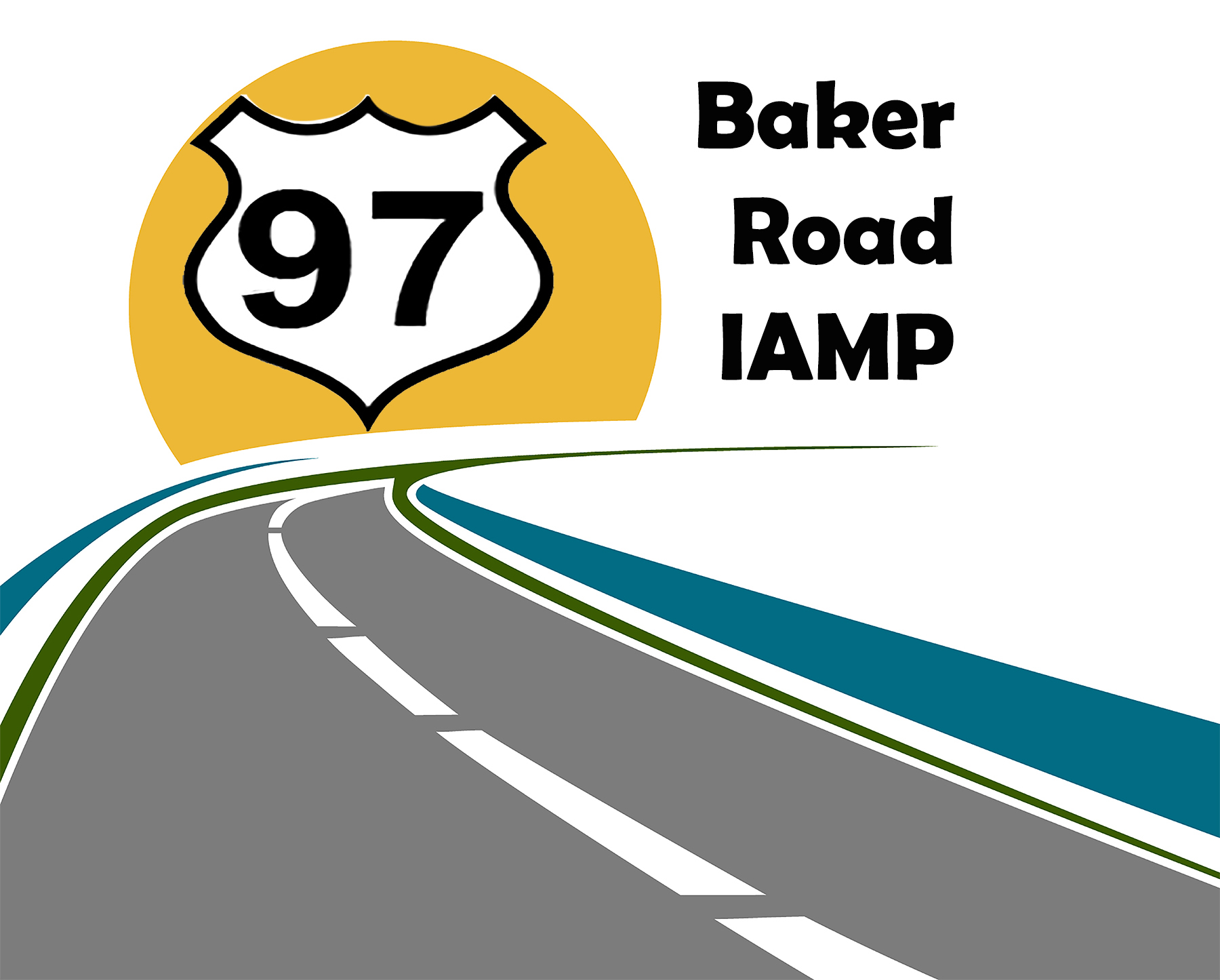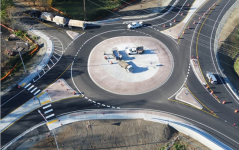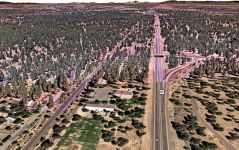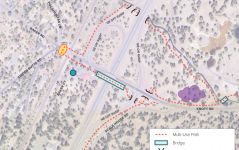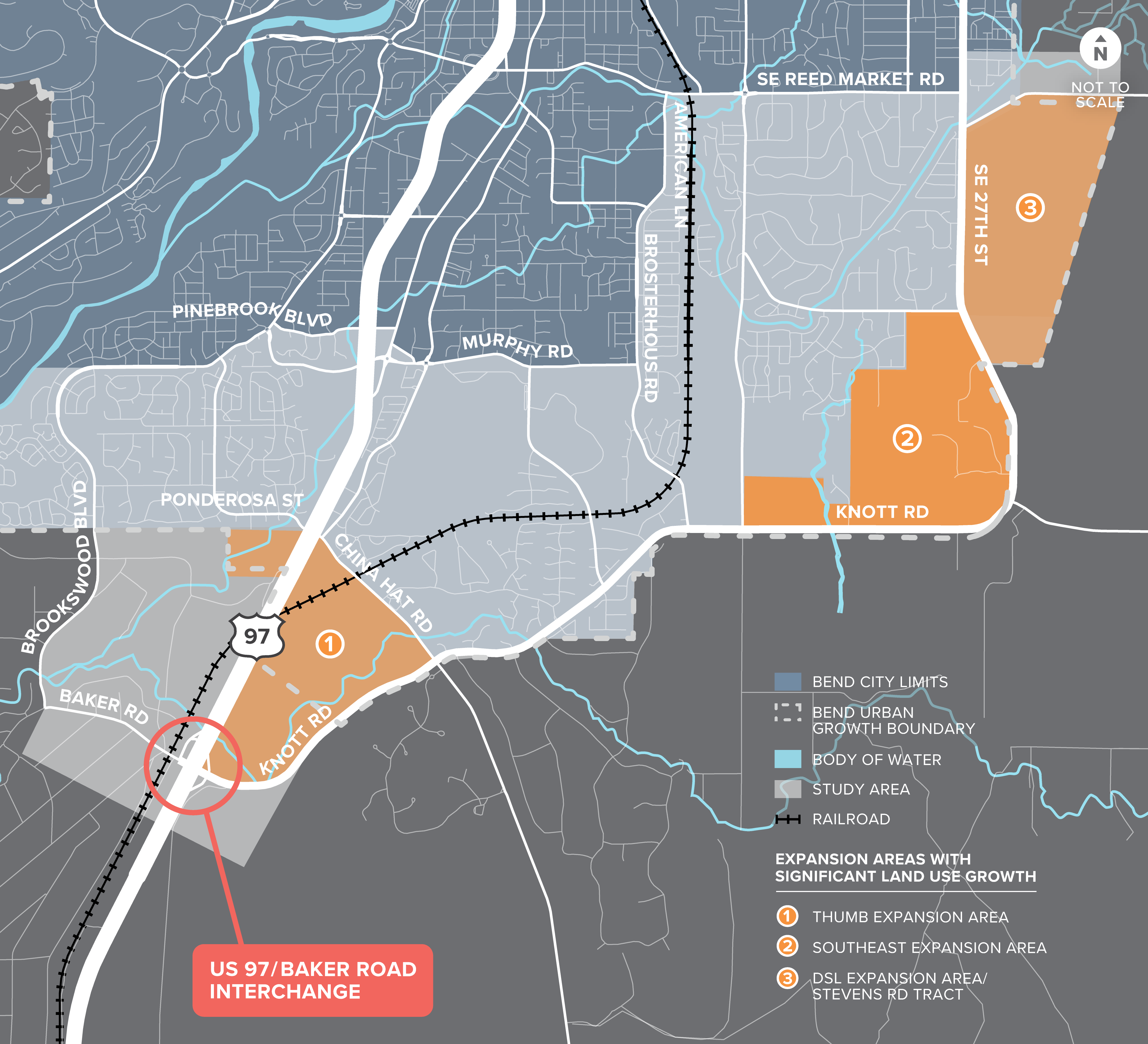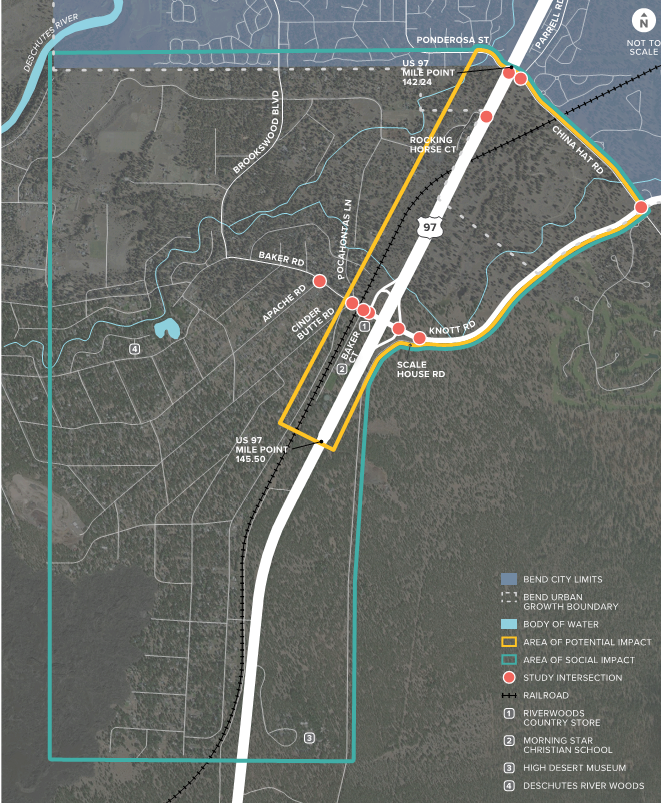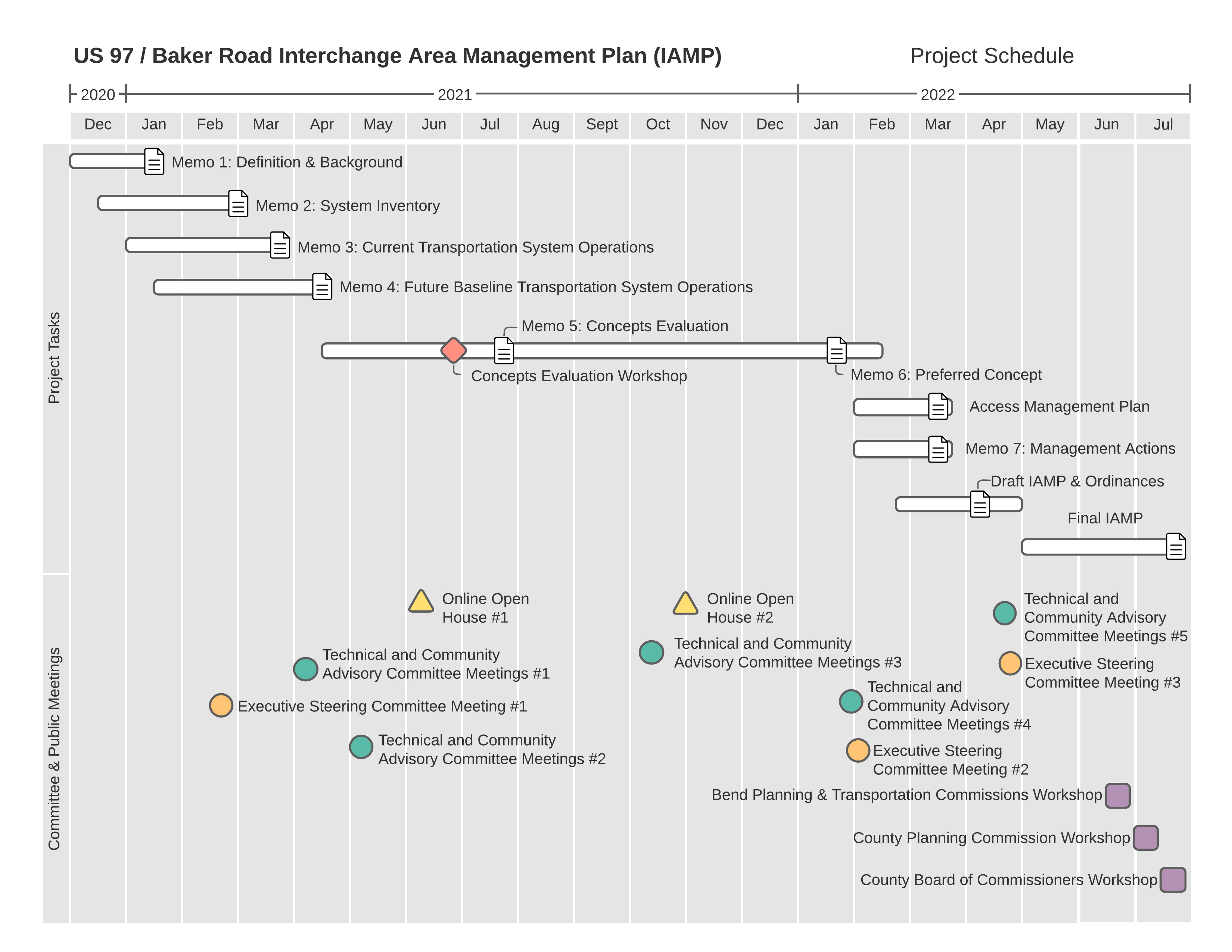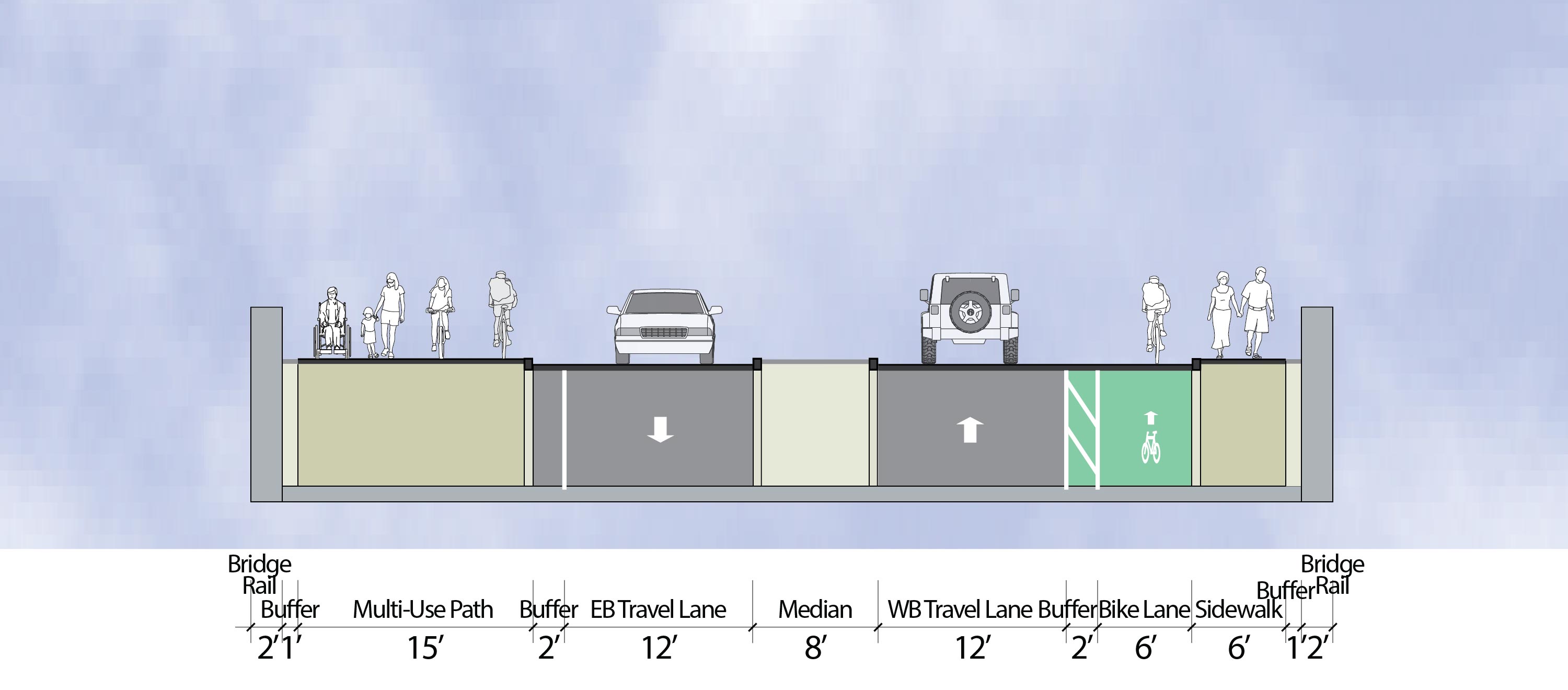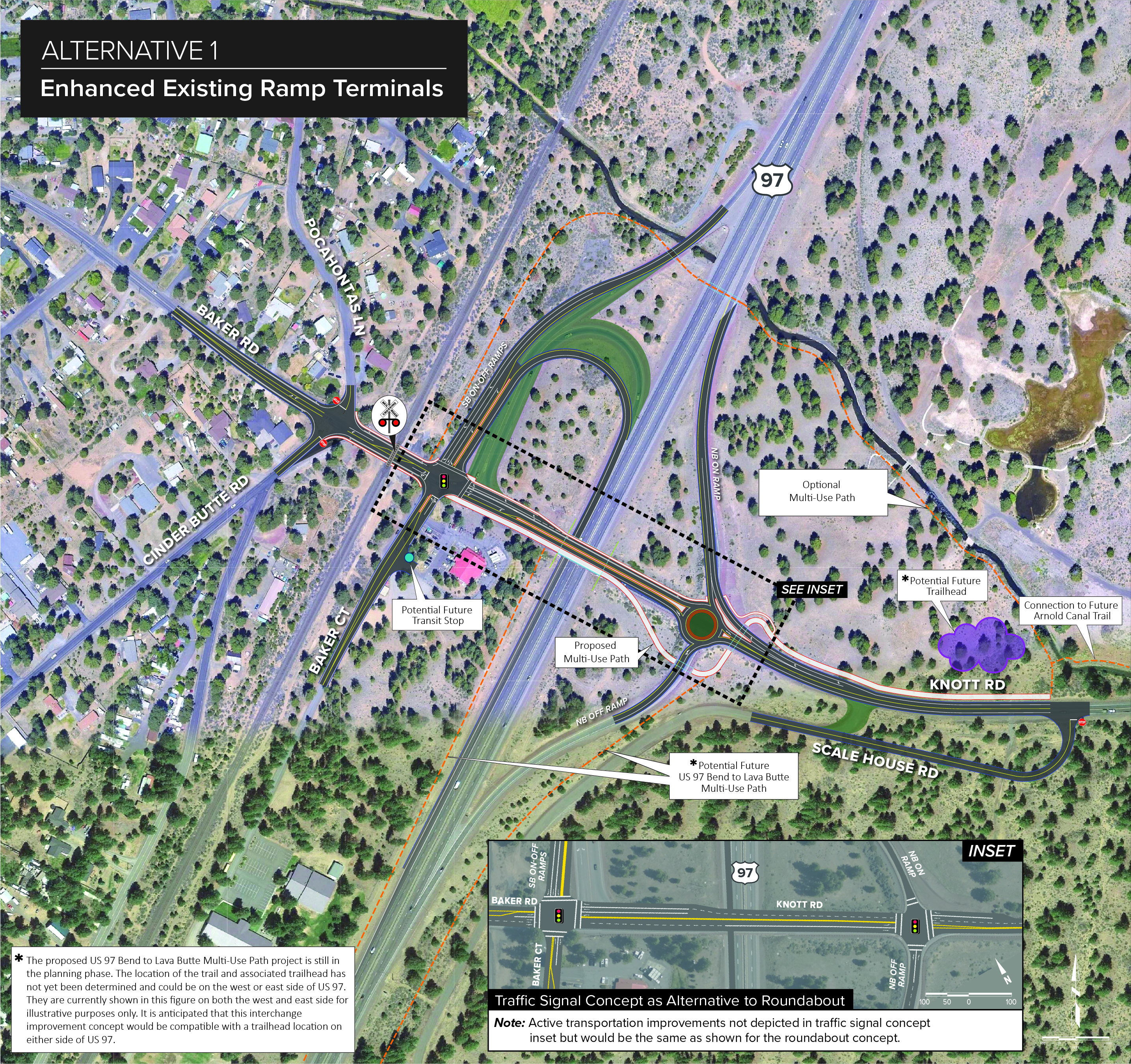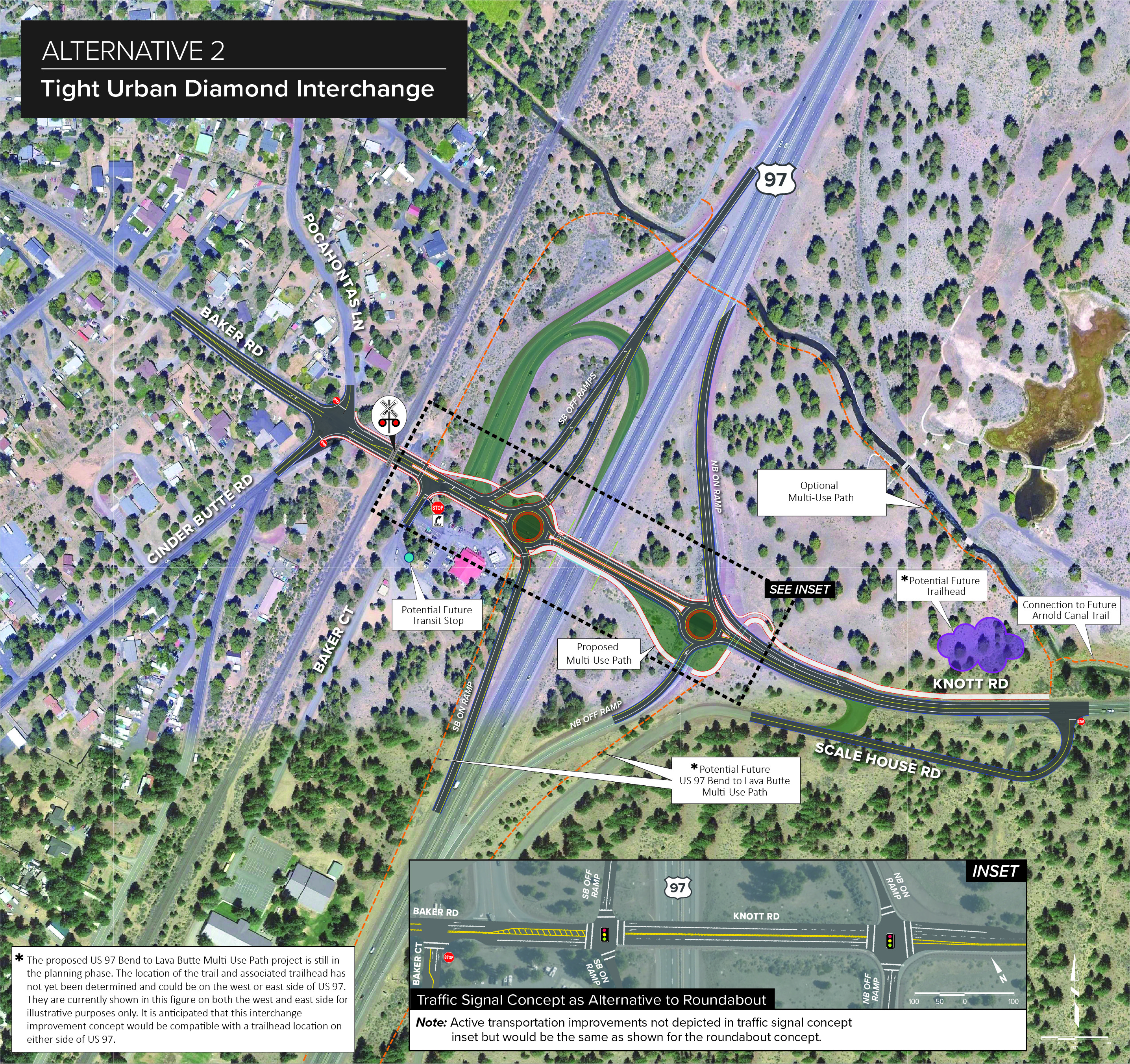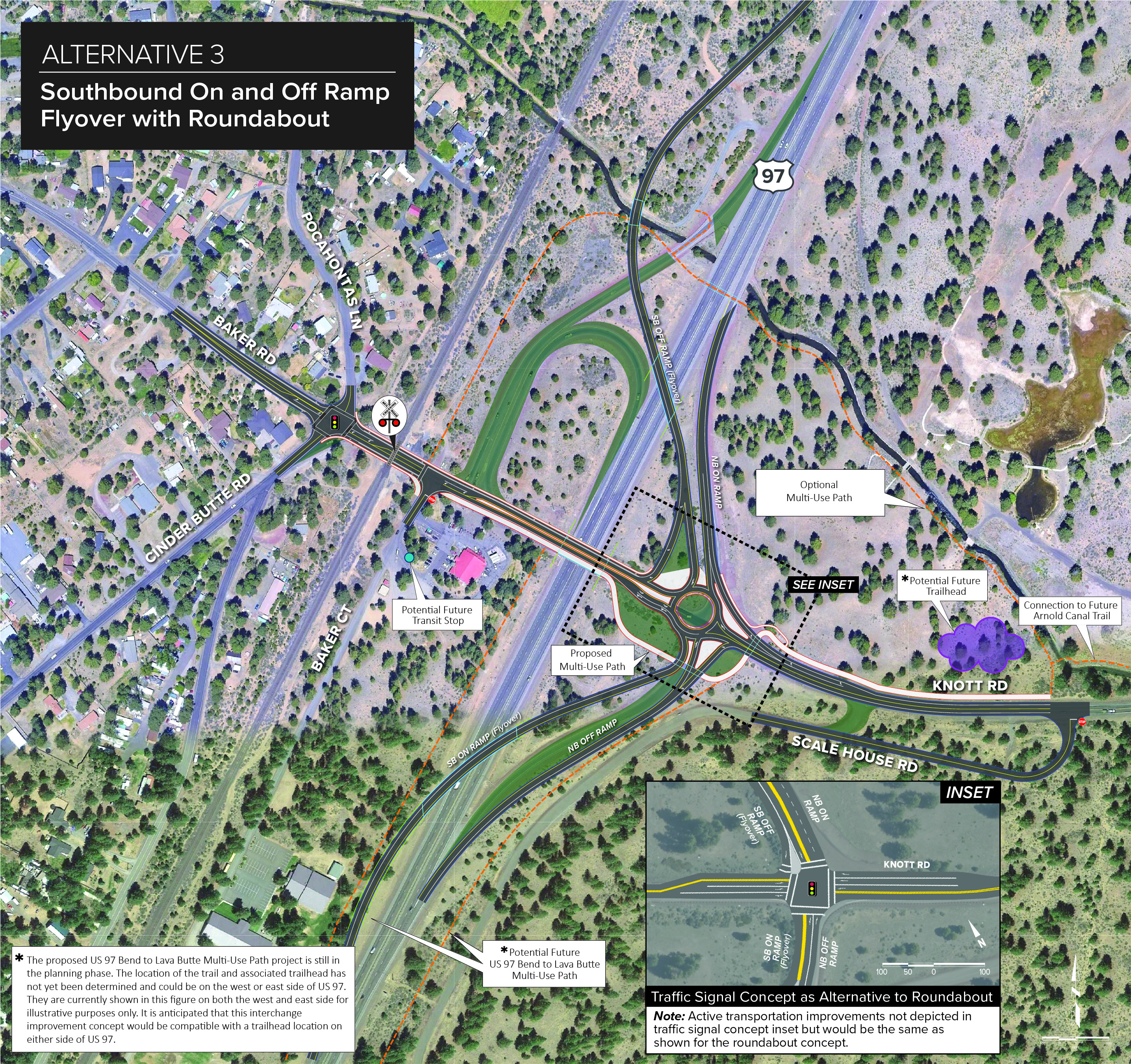For ADA (Americans with Disabilities Act) or Civil Rights Title VI accommodations, translation/interpretation services, or more information call 503-731-4128, TTY 800-735-2900 or Oregon Relay Service 7-1-1.
Stations
How will an IAMP benefit the area?
The US 97/Baker Road interchange is about 30 years old. When it was constructed, it served sparsely developed rural lands south of Bend and accommodated freight traffic passing between US 97 to the south and US 20 to the east. Bend's population is now nearly four times greater, and the urban growth boundary will likely expand toward the interchange within the next 20 years.
Increasing urban growth is causing congestion and safety issues in the interchange area, and facilities are limited for people walking or biking. These issues will intensify as housing and employment growth in Bend continues to move toward the interchange. Three major expansion areas to the east of the interchange are anticipated to include over 2,400 households and over 7,000 jobs by 2040.
(Growth Map. Click to enlarge.)
To address these issues, the IAMP seeks to:
- Ensure the safe and efficient operation of the interchange area for people driving, walking and biking over the next 20 years.
- Identify transportation improvements, management strategies and land use/policy actions needed to support planned development.
(Click to enlarge.)
Project Timeline and Next Steps
The project started at the end of 2020 and is on schedule for completion in summer 2022. A preferred alternative for the interchange area will be selected by the end of 2021. A draft plan will be developed this spring. The City and County will both hold workshops on the final plan this summer. See more details in the image below.
(Click to enlarge.)
Goals and Objectives
The project’s goals and objectives help guide the development of this plan for the interchange area and are used to evaluate how the solutions meet the project purpose and stakeholder values. Currently, eight goal areas focus on:
 Efficient (motor vehicle) travel
Efficient (motor vehicle) travel Improving safety for all modes of travel
Improving safety for all modes of travel Supporting regional and local economic development
Supporting regional and local economic development Creating opportunity for more multimodal travel
Creating opportunity for more multimodal travel
 Providing for equitable participation in the process and evaluating just allocation of burdens and benefits among community members
Providing for equitable participation in the process and evaluating just allocation of burdens and benefits among community members
 Environmental stewardship
Environmental stewardship
 Consistency with the shared state and local vision for the corridor/area
Consistency with the shared state and local vision for the corridor/area
 Developing realistic solutions
Developing realistic solutions
Early Concepts
- Enhance Existing Ramp Terminals
- Tight Urban Diamond Interchange
- Southbound On- and Off-Ramp Flyovers with Signalized Intersection
- Southbound On- and Off-Ramp Flyovers with Roundabout Intersection
- Southbound Off-Ramp Flyover with Signalized Intersection and Existing Southbound Loop On-Ramp
- Southbound Off-Ramp Flyover with Roundabout Intersection and Existing Southbound Loop On-Ramp
- Southbound Off-Ramp Flyover with Signalized Intersection and New Southbound Diamond On-Ramp
- Southbound Off-Ramp Flyover with Roundabout Intersection and New Southbound Diamond On-Ramp
Comments About the Concepts
- Concern that the team is considering too many high-cost options that won’t be implemented.
- General preference for roundabouts over signalized intersections.
- Consider wildfire evacuation routes.
- Support for the added bicycle and pedestrian facilities.
- Concern that the proposed work (within existing right of way) will not provide as much comfort as needed to pedestrians and cyclists.
- Concern over local property ingress and egress with the proposed alternatives.
Following the public outreach effort, the project’s Technical Advisory Committee held a workshop to compare and refine these concepts and three improvement alternatives were advanced. Learn more at the next station!
Improvements for People Walking, Biking, and Taking Transit
All alternatives include a comprehensive network of low-stress walking and biking facilities. This includes:
- Connections for proposed regional trails.
- Tunnels to eliminate street crossings.
- A wide multi-use path along the south side of Baker Road.
- Sidewalk with a buffered or protected bike lane on the north side of Baker Road.
In addition, the local transit stop is proposed to be relocated closer to the interchange near the Riverwoods Country Store. The figures below highlight the proposed network of walking and biking facilities and provide an example cross section of the bridge over US 97 to show what it could look like.
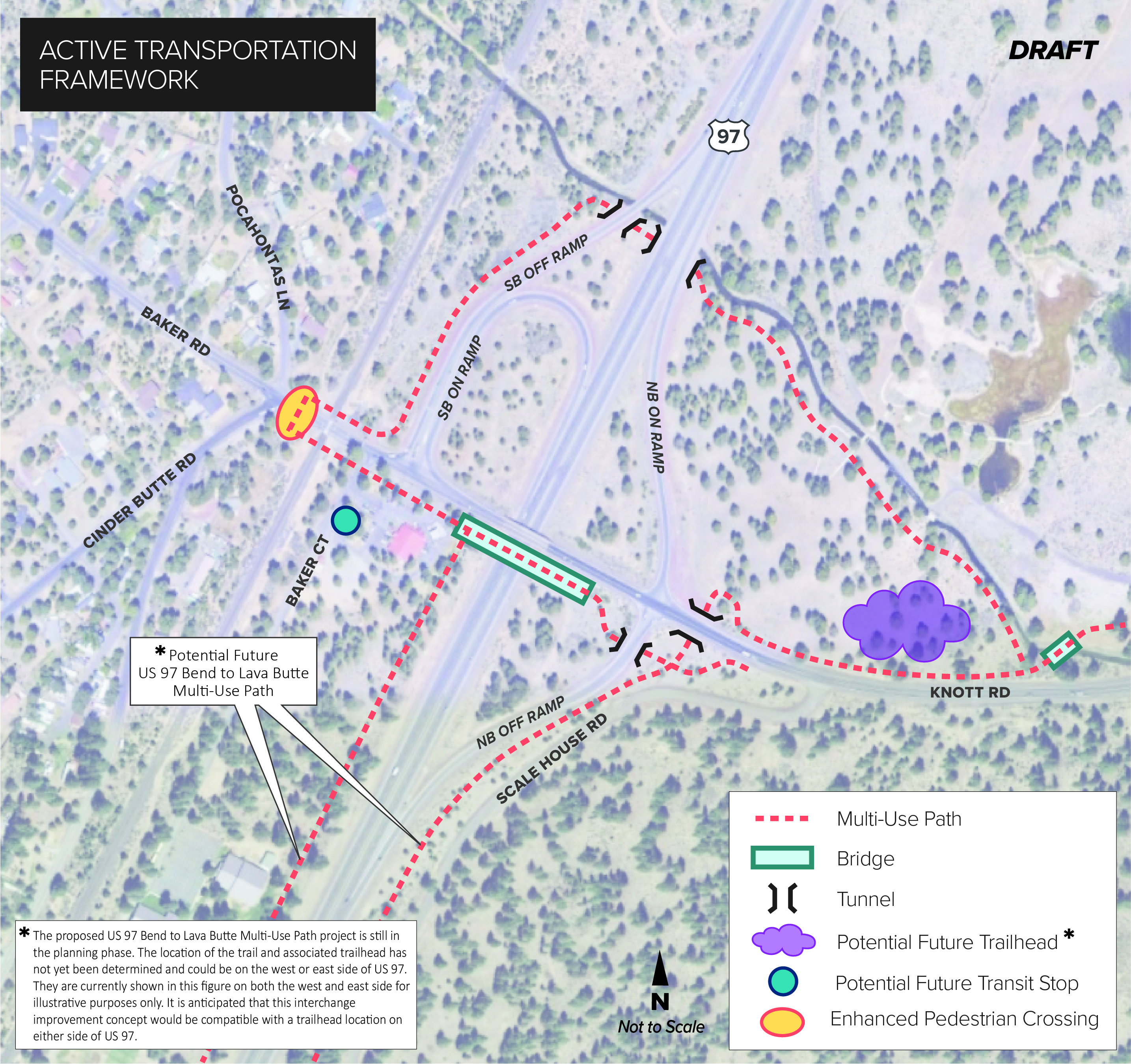
(Click to enlarge.)
(Click to enlarge.)
Improvements for People Driving
All alternatives will improve conditions for people driving. This includes:
- Effectively relieving congestion on Baker Road.
- Safely accommodating vehicles on the southbound off-ramp, keeping them away from high-speed traffic on US 97 even when there is a train crossing.
- Lengthening the southbound on-ramp to US 97 to improve the ability for drivers to accelerate to safe merging speeds.
- Providing left turn lanes at intersections on Baker Road to reduce the potential for rear end collisions and relieve congestion from stopped cars.
- Supporting wildfire evacuation by eliminating potential bottlenecks and reducing conflict areas.
Roundabouts or Traffic Signals
All alternatives include roundabouts at one or more US 97 ramp intersections on Baker Road. Roundabouts on the state highway system are subject to a stakeholder engagement process, including the freight community. Depending on the outcome of that process, traffic signals may be necessary. Therefore, the team evaluated both options.
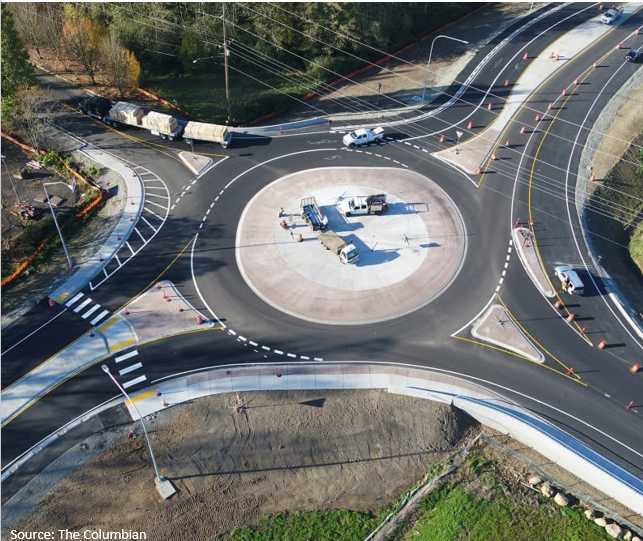
Alternative 1: Enhance Existing Ramp Terminals
Alternative 1 simplifies the southbound ramps and Baker Court access while adding a traffic signal and roundabout to relieve congestion, minimizing the amount of interchange reconstruction to reduce the project cost and degree of property impacts.
Key elements:
- The southbound ramps are aligned with Baker Court and the intersection is signalized to eliminate existing turning conflicts and relieve congestion.
- A roundabout relieves congestion at the northbound ramp intersection and eliminates the need for more turn lanes on Baker Road that would result in further bridge widening.
- Provides a complete low-stress network of walking and biking facilities that includes connections to proposed regional trails.
- Left turn lanes are provided on Baker Road at Cinder Butte Road.
Key differentiators:
- While this alternative is effective at relieving congestion, there would be slightly more congestion than under some of the other alternatives.
- The option to construct a traffic signal at the northbound ramp intersection instead of a roundabout does not manage queues as well but will perform adequately with little congestion expected.
- This alternative improves safety for all modes of travel. While the new intersection with the southbound ramps and Baker Court is very close to the railroad crossing, traffic signal coordination with the railroad crossing will be used to clear vehicles away from the tracks before train arrivals.
- A new traffic signal at the northbound ramps provides a wide, but controlled pedestrian and bicycle crossing of Baker Road.
- Would be the easiest alternative to construct.
- Expected to be the lowest cost alternative at an estimated $14.1 million.*
Alternative 2: Tight Urban Diamond Interchange (TUDI)
Alternative 2 reduces turning conflicts with Baker Court by moving the southbound ramps further to the east and uses roundabouts to relieve congestion while minimizing the need to widen the bridge over US 97.
Key elements:
- Reconstructs the interchange to use a more traditional “diamond” configuration with roundabouts at the ramp intersections on Baker Road.
- Provides a complete low-stress network of walking and biking facilities that includes connections to proposed regional trails.
- Left turn lanes are provided on Baker Road at Baker Court and Cinder Butte Road. Under the roundabout option, left turns out of Baker Court would not be allowed. Instead, drivers must turn right, then make a U-turn at the roundabout.
Key differentiators:
- With the roundabouts, this alternative is very effective at relieving congestion. It will be slightly more effective than Alternative 1, but not quite as effective as Alternative 3.
- Most vehicle queues are very short because of the roundabouts. Eastbound queues from the southbound ramp intersection may still block Baker Court but there would not be queued vehicles across the railroad tracks.
- The left turn lane into Baker Court is relatively short and could be a problem during the busier morning period when school traffic is present.
- This alternative improves safety for all modes of travel. However, it is the only one to include a street crossing with the low-stress multi-use path along the south side of Baker Road (though it only involves a single lane of traffic).
- The roundabout option requires minimal widening of the bridge over US 97, with only two lanes of motor vehicle traffic needed across the bridge.
- Expected to be the second lowest cost alternative at an estimated $18.3 million for the roundabout option.*
Alternative 3: Southbound On- And Off-Ramp Flyovers with Roundabout (Flyover Interchange)
Alternative 3 reduces turning conflicts with Baker Court and minimizes the impacts of train crossings by consolidating the southbound and northbound ramp intersections on Baker Road into one location on the east side of US 97.
Key elements:
- All ramp access on Baker Road occurs at a single intersection that is well separated from other intersections and the railroad.
- Large southbound “fly-over” ramps would be constructed to allow those movements to cross over US 97.
- Provides a complete low-stress network of walking and biking facilities that includes connections to proposed regional trails.
- Left turn lanes are provided on Baker Road at Baker Court and Cinder Butte Road, with a proposed traffic signal at Cinder Butte Road.
Key differentiators:
- This alternative is the best at relieving congestion, though only slightly better than Alternative 2.
- May have the best safety performance because it eliminates the most conflict points for all modes of travel and provides more distance from the railroad crossing.
- This alternative best supports regional and local economic development as it best relieves congestion and has the lowest potential to impact the railroad crossing.
- The large fly-over ramps may not provide the desired look as a gateway to Bend from the south.
- The Baker Road/ Cinder Butte intersection is signalized to provide a controlled west side pedestrian and bicycle crossing.
- Would be the most difficult alternative to construct or build in smaller phases.
- Expected to cost significantly more than the other alternatives at an estimated $34.5 million for the roundabout option.*
*Cost estimate represents option with roundabout. Cost estimate not yet available for an option with all traffic signals.
Summary of Alternatives Evaluation
As described in the alternatives above, each was evaluated against the goals and objectives. A summary of the results are illustrated in the following table.
|
Goals |
No-Build |
Alt. 1 (Enhance existing) |
Alt. 2 (TUDI) |
Alt. 3 (FLYOVER) |
1. Provide for efficient travel through the interchange area based on existing and planned land uses in the area. |
 |
 |
 |
 |
2. Improve safety for all modes of travel. |
 |
 |
 |
 |
3. Support regional and local economic development. |
 |
 |
 |
 |
4. Facilitate the use of multimodal travel options. |
 |
 |
 |
 |
5. Develop the project to support the community’s value of equity. |
 |
 |
 |
 |
6. Practice good stewardship of the environment. |
 |
 |
 |
 |
7. Develop solutions that are consistent with the established shared corridor vision and adopted state and local plans. |
 |
 |
 |
 |
8. Develop implementable solutions for the interchange area. |
N/A |
 |
 |
 |
Stay Involved:
- Join the project’s email list to get project updates, including the preferred alternative for the interchange area.
- For more information on the project, visit the project website.
